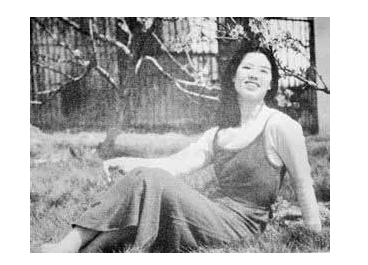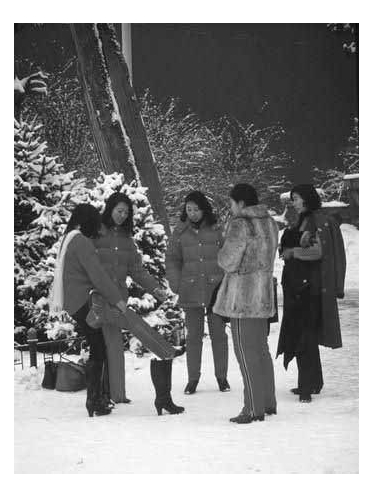China has become the world's largest manufacturer and consumer of clothing. Large cities not only feature various domestic and overseas famous brand franchise stores, but also countless stands selling low-cost clothes.
When the People's Republic of China was established, China's intelligentsia was fond of both Western-style suits and Chinese-style robes. Cheongsams were particularly popular among women.
Traditional Styles began to Change
As new China's ideology changed, Western-style suits and traditional clothes gradually faded from the mainstream. Instead, people imitated cadres' uniforms. Chairman Mao Zedong's favorite suit, known in the West as a "Mao suit," but actually designed and first worn by Sun Yat-sen, also became popular among common people. The outfit evolved into the single breasted "People's Suit," featuring sharp lapels and slanting pockets. Blue, grey and black were the colors of choice.
In the 1950s and early 60s, China was deeply influenced by the Soviet Union, even in clothing styles. The "Lenin Coat," featuring double lines of buttons, slanting pockets and a belt, came into vogue. In the meantime, people were keen on shirts based on the Soviet tank-crew uniform. In this period, most Chinese women liked to wear platye (a Russian word referring to a woman's button-up dress). The Soviet female experts working in China and heroines in Soviet literature often wore platyes, featuring round-collars, loose short sleeves, pleated hemlines and a belt. The design was well received among the Chinese female intelligentsia. Platyes were often made from cotton and were printed with dense flower, tartan or striped patterns. China used to import large quantities of patterned fabric and called for people to purchase it. At that time, even pedicab drivers wore cotton print.
During this period clothes were also influenced by other socialist countries. For example, a kind of sweater from Albania was quite popular in China.
Money was very tight, so clothes were generally simple and unadorned. Being a tailor was an enviable job, since most people had their clothes handmade. Girls who were good at needlework always had a host of admirers chasing after them. The ability to repair old clothing was one of the criteria by which good tailors were judged.

From 1954 to 1983 people had to buy clothing with coupons in China. Especially in the late 1950s and early 60s, everything had to be purchased with coupons. The average city person could only afford three or four meters of cloth a year. As a result, people could only add new clothes during Spring Festival. Parents usually chose a bigger size when buying clothes for children so they would grow into them. It was common to pass down a coat from the older brothers and sisters to the younger siblings. People usually chose solid materials and black, blue and gray colors, so the clothes would last.
Cloth and military shoes were common. But military uniforms at this point were rare, since being a soldier was traditionally regarded as not a good job.
An Ocean of Army Green
Military uniforms became popular during the "cultural revolution" (1966-1976), an era in which people admired soldiers. Young men often wore green uniforms, a Sam Browne belt, a Chairman Mao badge, a green bag, a Red Guard armband, military shoes, and waved a copy of the "little red book" – Quotations from Chairman Mao. Young women were also encouraged to put on military uniforms by one of Mao Zedong's poems that exalts women who favor masculine heroism more than feminine beauty. The pushing of a singular ideology led to a uniform dress style, and in this period only military uniforms and "Mao suits" could be seen in China.
In the mid-1970s Mao's wife Jiang Qing improved the platye and made it completely Chinese in style. Though many female cadres hastened to wear it, it wasn't popular among common people.
The "cultural revolution" required people to abolish "antiquated" concepts, culture and dress, as well as everything related to the bourgeoisie. As a result, people wore neither traditional Chinese costumes nor Western-style suits. Those who wore jewelry or put on make-up faced serious consequences. To show their austerity, people even washed new clothes a few times to make them look timeworn. It is now considered a repressive and tedious period.
The Arrival of Fantastic Garb
Dress in China underwent a drastic change after the "cultural revolution." In 1979, French designer Pierre Cardin held a fashion show in Beijing. His bold and futuristic designs excited Chinese audiences, most of whom were still wearing simple cotton-padded jackets. At that time, clothing different to common apparel was known as "fantastic garb." One example was flared trousers. These items were looked down upon from the high plane of ethics and politics, and wearers of flares were regarded as hooligans. It was not unusual to see teachers take a pair of scissors to students' bell-bottomed pants at that time.
Gradually, people came out from under the shadow of class struggle. State leaders began to wear Western-style suits in the 1980s. Soon after that, suits became all the rage in China. But some people cut a sorry figure, since ignorance of dress etiquette ran high. Suits were often worn with cloth shoes, or with shirts hanging out over people's belts.
In 1984, a film named Red Dresses Are in Fashion, telling the story of a female textile worker, rectified the attitude towards so-called "fantastic garb." The model worker in the film put on stylish red skirt like other girls on the street. This was the mainstream media's affirmation of beautiful clothing, and red skirts became the most popular female clothing item that year. In 1986, the media again led the trend: a report Yellow Skirts Are Prevalent in Beijing from China Textile Newspaper, meant yellow skirts were soon popular across the country. In the late 1980s, short skirts were gradually embraced by Chinese women, who later became accustomed to wearing them with sweaters during spring and autumn. At that time, copying styles was the way to stay in fashion, and girls were not embarrassed to all dress the same.
During the late 1980s, fashion shows became a major component of people's cultural life. As well as professional models, people were deeply interested in organizing amateur teams for the elderly and children. Chinese fashion gradually became integrated with global trends.

Individual Styles
Since the 1990s, a sewing machine has no longer been a vital necessity for most Chinese families. Chinese people started to buy ready-made clothes, and most work in the once-booming tailor shops now involves altering garments. China has become the world's largest manufacturer and consumer of clothing. Large cities not only feature various domestic and overseas famous brand franchise stores, but also countless stands selling low-cost clothes. Consumers, especially young people, prefer roaming garment markets and dressing distinctively. "I can dress anyway I like" has become the prevalent attitude. Wearing the same clothes or colors as others now makes people embarrassed. A fashion magazine summed up the globalization of fashion: it is no surprise that a fashionable dress issued in Milan or Paris one day is being worn by women in Beijing or Shanghai the next.
For youths, stars' dress sense has a considerable influence over their choice of apparel. Unlike their parents, they wear casual outfits without hesitation. The prevalence of color in men's wear has fundamentally altered China's formerly drab attire. Moreover, the changes in women's wear have confounded the older generation. The fashion for slip dresses, for example, was in the making for nearly two years. Initially they were worn with coats. As coats became simplified, the dress' material becomes more and more transparent and light. The slip dress started to be really popular around 1998, and is still in vogue now.
People's dress sense has become a matter of personal taste and individual personality. As well as style, material is an important factor. Natural materials such as pure cotton are quite popular. Expensive ones like cashmere have also entered ordinary people's lives, while some fashionable stars are now promoting the ethics of dressing. "It is a disgrace to dress me up at the cost of an animal's life," said popular Chinese actress Sun Li, who never wears fur and was awarded the "2008 Best Dressed" by People for the Ethical Treatment of Animals, an international animal rights organization.
In line with the growth of national power, people's confidence and sense of pride to their own culture has also increased. Movie star Maggie Cheung wore over 20 cheongsams in the popular film In the Mood for Love, which gave Chinese women a feel for the beauty of traditional Chinese clothing. Cheongsams have consequently become a favorite style once again. Showing little resemblance to the cheongsams of the Qing Dynasty (1644-1911), today's dresses reveal not only the distinctive elegance and tenderness of Chinese women, but also their graceful posture. Revised Chinese jackets have also enjoyed a resurgence in popularity after world leaders were photographed wearing Tang-style suits at the APEC meeting in Shanghai in 2001.
People who love Chinese classical culture have advocated the campaign for Han Dynasty costume. They believe stylish Chinese styles actually embody the characteristics of ethnic minorities in north China, but not the genuine clothing of the Han majority, which impressed people with its free and elegant feeling. Participants in the campaign are mainly young people born in the 1980s and 1990s.





